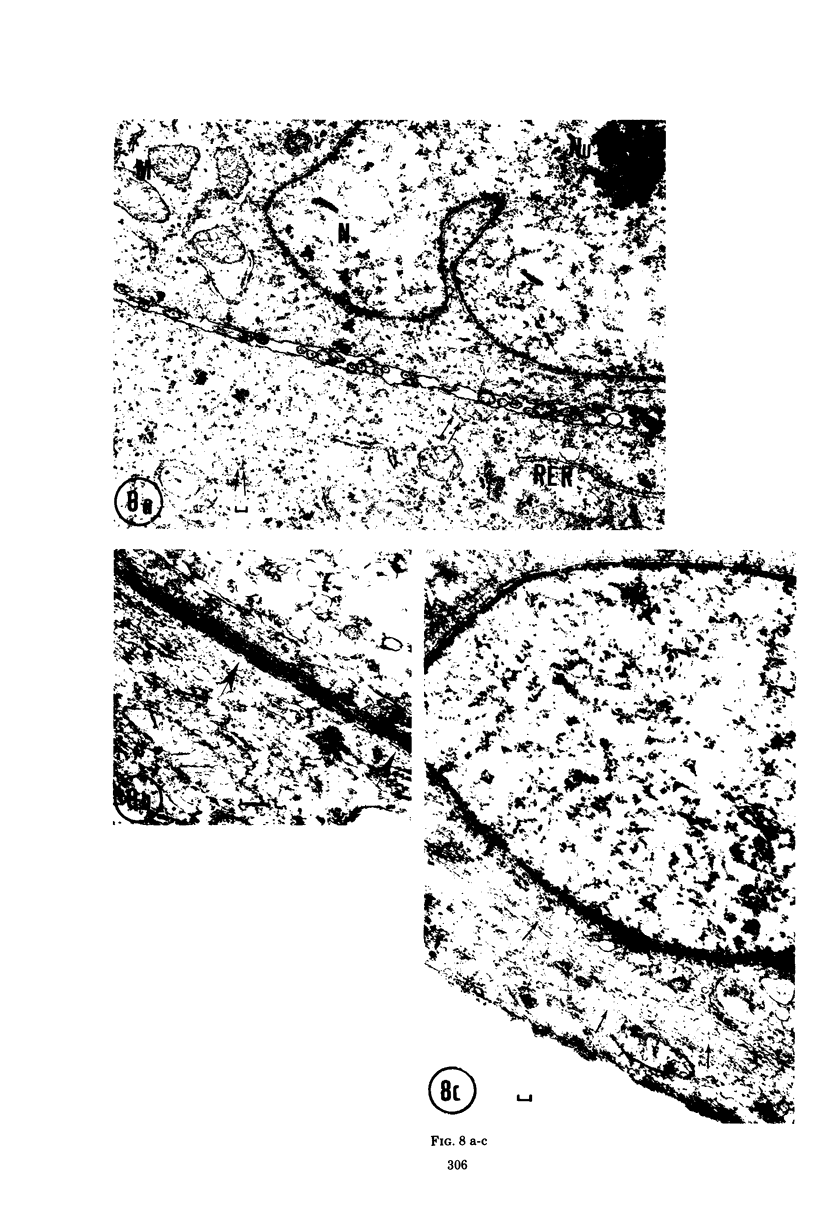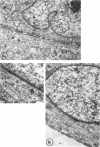Abstract
37 RC cells, a cultured line derived from African green monkey kidneys, survived long treatments with actinomycin D (AMD; 0.1 to 0.5 μg/ml) under strong inhibition of ribonucleic acid synthesis and blocking of cell division. One aspect of the complex cellular response to this treatment was a progressive lowering of the influx rate of AMD and, consequently, of its endocellular concentration, leading to a late resurgence of transcription. Overall protein synthesis decreased in AMD-treated cells, but more of the residual protein was exported to the cell surface, a fact associated with the development of numerous strands of endoplasmic reticulum and Golgi bodies in the cytoplasm. The lowering of AMD influx during the treatment was not simply due to the decay of protein synthesis, and there was no evidence for a carrier-mediated transport of the drug. It was paralleled by, but seemingly not related to, modifications in cellular microtubules and microfilaments. The rate of AMD influx was restored to levels comparable to those of untreated cells by short exposure to ethylenediaminetetraacetic acid and trypsin. It is concluded that the changes in plasma membrane of 37 RC cells, creating an obstacle to the influx of AMD after long treatment with this drug, probably consist of an accumulation and/or a different distribution of glycoproteins or other surface components on the cell surface.
Full text
PDF












Images in this article
Selected References
These references are in PubMed. This may not be the complete list of references from this article.
- Benedetto A., Delfini C., Carloni G., Djaczenko W. Study on the reinitiation of transcription in 37 RC cells after actinomycin D inhibition. Spectrum of major RNA species resynthesized after maximal suppression by the drug. J Cell Biol. 1975 Dec;67(3):538–550. doi: 10.1083/jcb.67.3.538. [DOI] [PMC free article] [PubMed] [Google Scholar]
- Benedetto A., Delfini C., Puledda S., Sebastiani A. Actinomycin D binding to 37 RC and HeLa cell lines. Biochim Biophys Acta. 1972 Dec 6;287(2):330–339. doi: 10.1016/0005-2787(72)90382-6. [DOI] [PubMed] [Google Scholar]
- Benedetto A., Djaczenko W. 37RC cells rapidly recover their RNA synthesis after inhibition with high doses of actinomycin D. J Cell Biol. 1972 Jan;52(1):171–174. doi: 10.1083/jcb.52.1.171. [DOI] [PMC free article] [PubMed] [Google Scholar]
- Biedler J. L., Riehm H. Cellular resistance to actinomycin D in Chinese hamster cells in vitro: cross-resistance, radioautographic, and cytogenetic studies. Cancer Res. 1970 Apr;30(4):1174–1184. [PubMed] [Google Scholar]
- Bosmann H. B. Mechanism of cellular drug resistance. Nature. 1971 Oct 22;233(5321):566–569. doi: 10.1038/233566a0. [DOI] [PubMed] [Google Scholar]
- Bowen D., Goldman I. D. The relationship among transport, intracellular binding, and inhibition of RNA synthesis by actinomycin D in Ehrlich ascites tumor cells in vitro. Cancer Res. 1975 Nov;35(11 Pt 1):3054–3060. [PubMed] [Google Scholar]
- Buck C. A., Glick M. C., Warren L. A comparative study of glycoproteins from the surface of control and Rous sarcoma virus transformed hamster cells. Biochemistry. 1970 Nov 10;9(23):4567–4576. doi: 10.1021/bi00825a016. [DOI] [PubMed] [Google Scholar]
- Cooke P. H., Fay F. S. Correlation between fiber length, ultrastructure, and the length-tension relationship of mammalian smooth muscle. J Cell Biol. 1972 Jan;52(1):105–116. doi: 10.1083/jcb.52.1.105. [DOI] [PMC free article] [PubMed] [Google Scholar]
- Cremisi C., Sonenshein G. E., Tournier P. Studies on the mechanism of actinomycin D resistance of an SV40-transformed hamster cell line. Exp Cell Res. 1974 Nov;89(1):89–94. doi: 10.1016/0014-4827(74)90190-6. [DOI] [PubMed] [Google Scholar]
- Culp L. A. Substrate-attached glycoproteins mediating adhesion of normal and virus-transformed mouse fibroblasts. J Cell Biol. 1974 Oct;63(1):71–83. doi: 10.1083/jcb.63.1.71. [DOI] [PMC free article] [PubMed] [Google Scholar]
- Djaczenko W., Cassone A. Visulization of new ultrastructural components in the cell wall of Candida albicans with fixatives containing TAPO. J Cell Biol. 1972 Jan;52(1):186–190. doi: 10.1083/jcb.52.1.186. [DOI] [PMC free article] [PubMed] [Google Scholar]
- Goldstein M. N., Hamm K., Amrod E. Incorporation of triated actinomycin D into drug-sensitive and drug-resistant HeLa cells. Science. 1966 Mar 25;151(3717):1555–1556. doi: 10.1126/science.151.3717.1555. [DOI] [PubMed] [Google Scholar]
- JOURNEY L. J., GOLDSTEIN M. N. Electron microscope studies on HeLa cell lines sensitive and resistant to actinomycin D. Cancer Res. 1961 Aug;21:929–932. [PubMed] [Google Scholar]
- Johnson H. V., Griffin M. J. Isolation and characteristics of HeLa surface proteins. Exp Cell Res. 1977 Oct 15;109(2):223–236. doi: 10.1016/0014-4827(77)90001-5. [DOI] [PubMed] [Google Scholar]
- Juliano R. L., Ling V. A surface glycoprotein modulating drug permeability in Chinese hamster ovary cell mutants. Biochim Biophys Acta. 1976 Nov 11;455(1):152–162. doi: 10.1016/0005-2736(76)90160-7. [DOI] [PubMed] [Google Scholar]
- Kessel D., Bosmann H. B. On the characteristics of actinomycin D resistance in L5178Y cells. Cancer Res. 1970 Nov;30(11):2695–2701. [PubMed] [Google Scholar]
- LOWRY O. H., ROSEBROUGH N. J., FARR A. L., RANDALL R. J. Protein measurement with the Folin phenol reagent. J Biol Chem. 1951 Nov;193(1):265–275. [PubMed] [Google Scholar]
- Lauweryns J. M., Baert J., De Loecker W. Fine filaments in lymphatic endothelial cells. J Cell Biol. 1976 Jan;68(1):163–167. doi: 10.1083/jcb.68.1.163. [DOI] [PMC free article] [PubMed] [Google Scholar]
- Lee J. C., Frigon R. P., Timasheff S. N. Structural stability of calf brain microtubule protein. Ann N Y Acad Sci. 1975 Jun 30;253:284–291. doi: 10.1111/j.1749-6632.1975.tb19207.x. [DOI] [PubMed] [Google Scholar]
- Perry R. P., Kelley D. E. Inhibition of RNA synthesis by actinomycin D: characteristic dose-response of different RNA species. J Cell Physiol. 1970 Oct;76(2):127–139. doi: 10.1002/jcp.1040760202. [DOI] [PubMed] [Google Scholar]
- Plagemann P. G., Ward G. A., Mahy B. W., Korbecki M. Relationship between uridine kinase activity and rate of incorporation of uridine into acid-soluble pool and into RNA during growth cycle of rat hepatoma cells. J Cell Physiol. 1969 Jun;73(3):233–249. doi: 10.1002/jcp.1040730308. [DOI] [PubMed] [Google Scholar]
- Sawicki S. G., Godman G. C. On the differential cytotoxicity of actinomycin D. J Cell Biol. 1971 Sep;50(3):746–761. doi: 10.1083/jcb.50.3.746. [DOI] [PMC free article] [PubMed] [Google Scholar]
- Sawicki S. G., Godman G. C. On the recovery of transcription after inhibition by actinomycin D. J Cell Biol. 1972 Nov;55(2):299–309. doi: 10.1083/jcb.55.2.299. [DOI] [PMC free article] [PubMed] [Google Scholar]
- Schluederberg A., Hendel R. C., Chavanich S. Actinomycin D; renewed RNA synthesis after removal from mammalian cells. Science. 1971 May 7;172(3983):577–579. doi: 10.1126/science.172.3983.577. [DOI] [PubMed] [Google Scholar]
- Singer R. H., Penman S. Messenger RNA in HeLa cells: kinetics of formation and decay. J Mol Biol. 1973 Aug 5;78(2):321–334. doi: 10.1016/0022-2836(73)90119-8. [DOI] [PubMed] [Google Scholar]
- Terry A. H., Culp L. A. Substrate-attached glycoproteins from normal and virus-transformed cells. Biochemistry. 1974 Jan 29;13(3):414–425. doi: 10.1021/bi00700a004. [DOI] [PubMed] [Google Scholar]
- Weisenberg R. C., Borisy G. G., Taylor E. W. The colchicine-binding protein of mammalian brain and its relation to microtubules. Biochemistry. 1968 Dec;7(12):4466–4479. doi: 10.1021/bi00852a043. [DOI] [PubMed] [Google Scholar]
- Wessells N. K., Spooner B. S., Ash J. F., Bradley M. O., Luduena M. A., Taylor E. L., Wrenn J. T., Yamada K. Microfilaments in cellular and developmental processes. Science. 1971 Jan 15;171(3967):135–143. doi: 10.1126/science.171.3967.135. [DOI] [PubMed] [Google Scholar]
- Williams J. G., Macpherson I. A. The differential effect of actinomycin D in normal and virus-transformed cells. J Cell Biol. 1973 Apr;57(1):148–158. doi: 10.1083/jcb.57.1.148. [DOI] [PMC free article] [PubMed] [Google Scholar]
- Wong K. T., Baron S., Levy H. B., Ward T. G. Dactinomycin: relative resistance of green monkey kidney cell cultures to its action. Proc Soc Exp Biol Med. 1967 May;125(1):65–67. doi: 10.3181/00379727-125-32014. [DOI] [PubMed] [Google Scholar]





